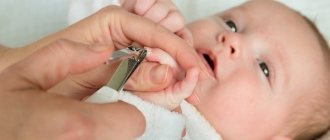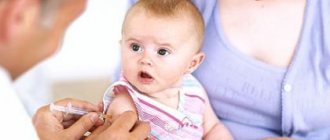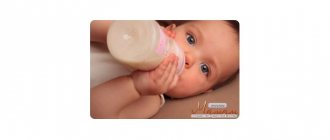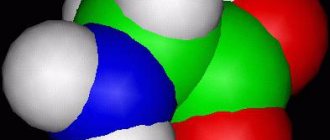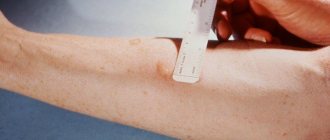Causes of allergies in infants
An allergic reaction can develop in a young child for various reasons.
- Lack of maturity of the gastrointestinal tract. It is because of this that babies so often have a negative reaction to food, in particular to proteins, carbohydrates and fats. The newborn’s body does not yet produce enzymes that break them down. Hence the negative reaction.
- Incomplete composition of microflora. Therefore, children up to a certain age are fed formula or breast milk and only gradually introduce new products upon reaching six months.
- Mom's diet during pregnancy and breastfeeding. If a woman consumed allergenic foods before the birth of her child, he may already have signs of allergies immediately after birth. If during lactation, then allergens reach the baby through mother's milk.
- Unsuitable mixtures. Breastfed babies are more susceptible to allergic reactions than breastfed babies. Especially those fed cow's milk based formulas.
- Immune system response. It protects the body from viruses and infections. But sometimes she can perceive even harmless substances as foreign and dangerous. And he begins to fight them. We see this as allergic reactions.
The listed reasons are more related to food allergies. But it also occurs most often in infants.
Miliaria in infants
Miliaria manifests itself as irritation on the baby’s skin, which is caused by increased sweating and slower evaporation of sweat.
This condition can occur not only in older children, but even in adults, but most often prickly heat occurs in infants, in whom the formation of sweat glands is just beginning.
With prickly heat, the rash looks like this:
- Bubbles can be pearlescent in color and up to two millimeters in diameter. This is the so-called crystalline type of disease. Bubbles tend to form groups. When rubbed against clothing, the bubbles burst and peeling of the skin begins in these places. As a rule, pearlescent prickly heat appears on the face, neck, and upper half of the baby’s body (on the back, on the chest).
- Miliaria rubra consists of blisters, each of which has a red spot around it. Such single blisters itch and hurt when you touch them. Localization is typical on the neck, armpits and groin.
- Miliaria profunda is characterized by flesh-colored formations up to three millimeters in diameter. Most often it is located on the chest, back of the baby, and on its limbs.
Typically, a doctor most often diagnoses a crystalline form of miliaria in infants. No special treatment is needed, the formations do not itch.
If the child is not overheated, such rashes will disappear after a few days.
In the case of red or deep form of miliaria, certain therapy is required, prescribed by a doctor.
When prickly heat appears in a baby, parents should not worry too much; they should consult a pediatrician and follow simple rules:
- Give your child air baths as often as possible.
- Do not put extra clothes on your baby.
- It is advisable that the temperature in the room does not exceed 22 degrees.
- Ensure frequent ventilation of the room.
- Change diapers on time.
To make heat rash in a baby disappear faster, the pediatrician can advise parents to use the following remedies:
- Powders containing zinc oxide and talc.
- Zinc-based ointment, which remarkably dries out blisters, reduces inflammation.
- Baths with chamomile infusions, strings.
Unfortunately, there are cases when harmless prickly heat becomes infected (from scratching). Then there is a risk of microbial eczema.
As soon as parents notice that the liquid in the baby's sweat blisters has become cloudy, the skin has turned red, and the temperature has risen, they should immediately call a doctor.
How do allergies manifest in babies?
Symptoms depend on the allergen, the baby's immune system and overall health, and other factors. We will tell you further what manifestations there may be.
Skin reactions
More often than not, allergy symptoms first appear through the skin. You may notice a rash, peeling, blisters, redness, and hives on the baby's body. Children who can speak complain of itching.
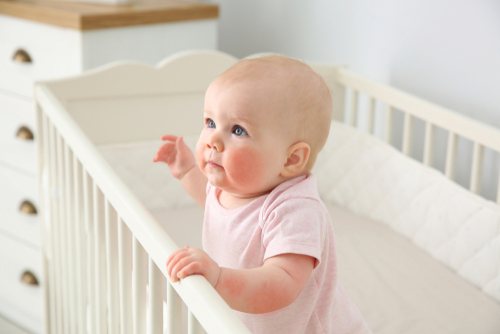
Another symptom is atopic dermatitis. Localized on the cheeks, elbows, under the knees, on the buttocks, neck, around the mouth and anus. The skin on the body in these places turns red and peels, and then begins to get wet and crusts appear.
Against the background of skin rashes and itching, the mood of the newborn also changes: from a cheerful baby, he turns into a capricious, nervous and irritable one. He sleeps and eats poorly, constantly cries and itches.
Gastrointestinal disorders
If parents have not taken measures to eliminate skin reactions, allergies can also cause problems in the gastrointestinal tract.
Constipation or diarrhea, bloating, reflux, colic - this is a list of problems that a baby may encounter.
How the eyes, nose and throat react
As a rule, a reaction from the respiratory and visual organs occurs to pollen, chemicals (paint, cosmetics), dust, fluff, and wool.
If a baby develops an atypical runny nose, watery eyes, or swollen mucous membranes, this may indicate an allergic reaction.
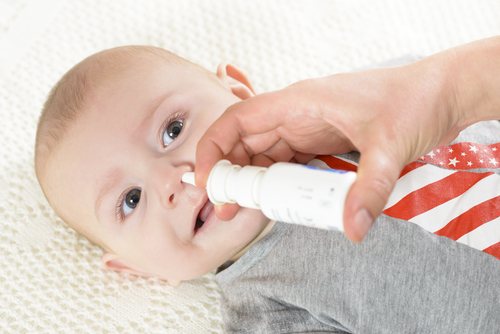
Also, from the respiratory system, a reaction may occur in the form of allergic bronchitis or asthma, sore throat, wheezing, noisy breathing.
Systemic reactions and critical conditions
An allergen can cause a fever.
In particularly severe cases, angioedema or anaphylactic shock are possible. These are critical conditions, they are rapidly getting worse. Require immediate medical attention.
These are the symptoms that are a reason to urgently call an ambulance: the skin turns pale, becomes locally tense, the newborn cannot breathe, and loses consciousness. In this case, time is counted in minutes, since there is a high risk of asphyxia - suffocation, as a result of which death occurs very quickly if help is not provided. To save the baby's life, parents will need to perform cardiopulmonary resuscitation.
Allergies in infants
How do allergies manifest in newborns? Hypersensitivity to irritants in infants can be divided into several groups.
Skin damage
Diathesis. Typically, this type of allergic reaction manifests itself in the form of redness of the cheeks, abdomen, back of the thighs and buttocks. The affected areas of the skin cause the baby to become itchy and wet if not properly cared for.
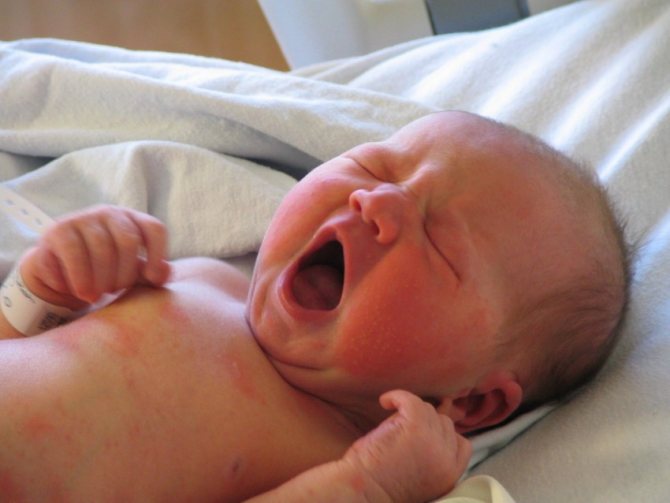
Rash. This type of allergic reaction most often appears on the baby’s forehead and cheeks. If you look at a photo of this type of allergy in a newborn, you can see that if the body’s reaction to the allergen is strong enough, the entire body can become covered in a rash. This reaction is popularly called urticaria.
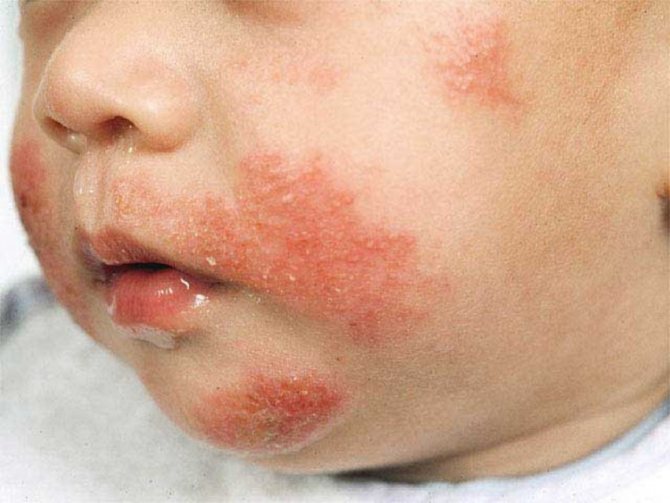
Seborrhea. Severe peeling of the skin in areas of increased hairiness. Most often it is the scalp and eyebrows.
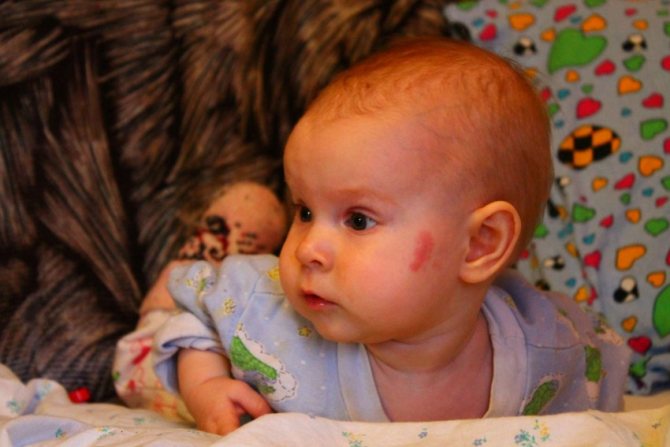
Diaper rash in high friction areas and baby's folds. When an allergy manifests itself in this way, the baby’s thin and delicate skin can crack and bleed. Most often, diaper rash appears behind the ears, on the neck, and in the groin.
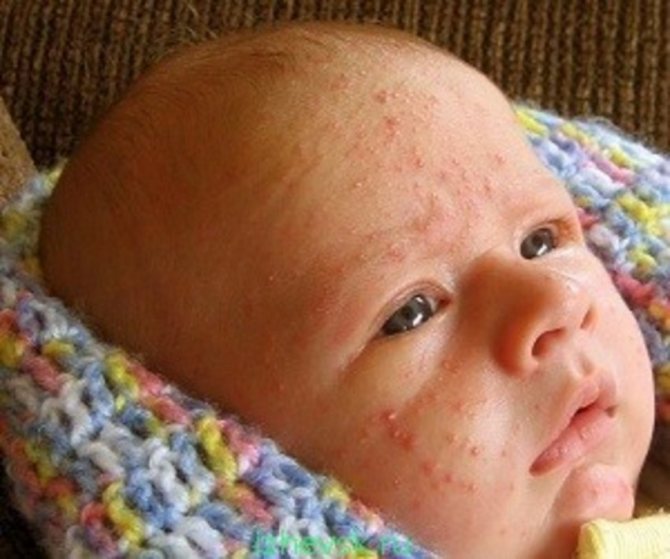
The appearance of prickly heat even with slight overheating.
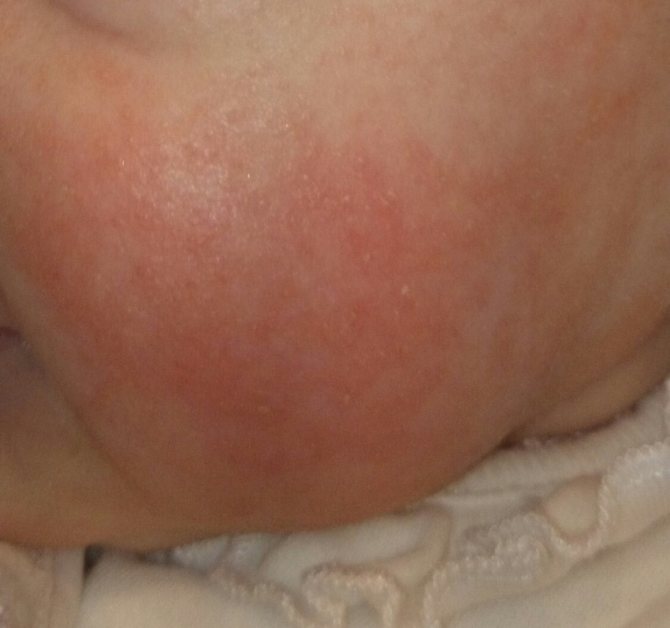
Allergic inflammation of the conjunctiva of the eye.
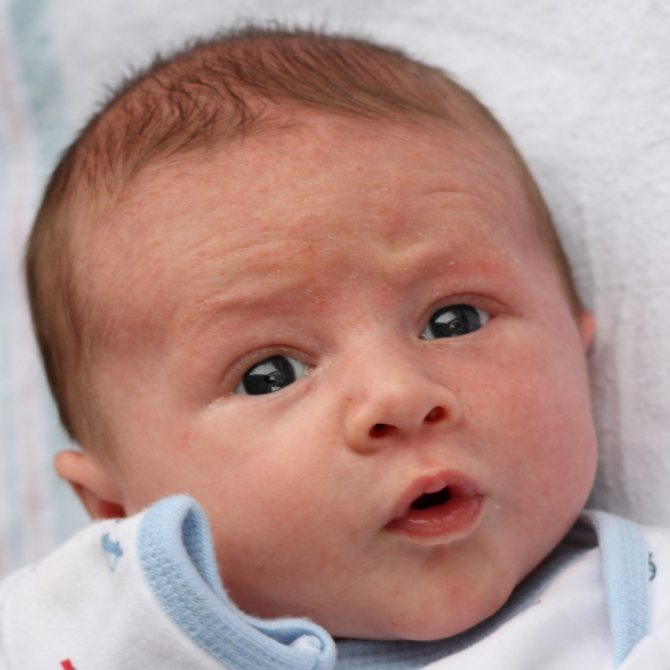
Digestive system dysfunction
This type of immune system hypersensitivity most often occurs when infants show signs of food allergies.
- Colic, flatulence, increased gas formation.
- Copious regurgitation, reminiscent of vomiting.
- Liquid, foamy stool.
- Imbalance of intestinal microflora.
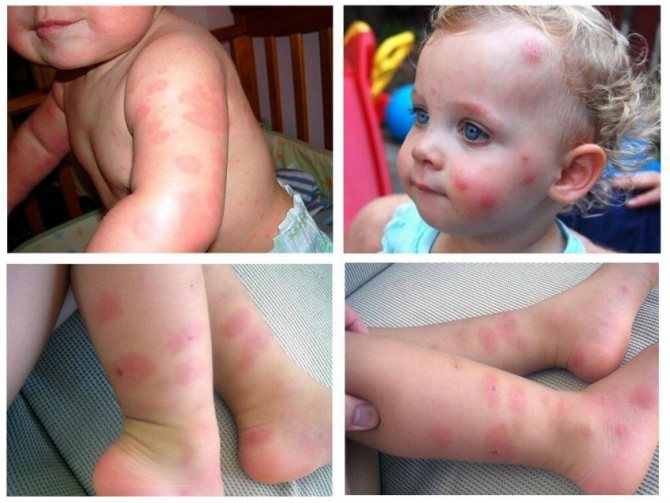
Respiratory system disorders
- Nasal congestion.
- Bronchial spasm.
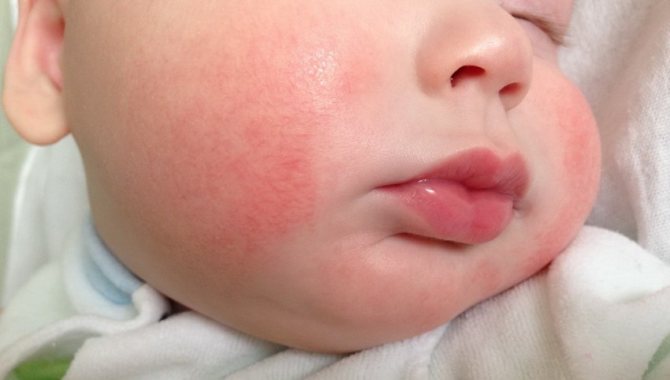
The most dangerous allergic reaction is Quincke's edema, which requires immediate medical intervention and can be fatal.
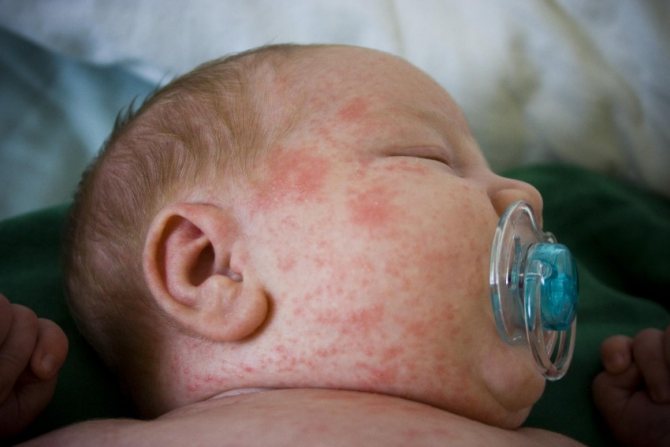
Symptoms of this condition include swelling of the soft tissues, accompanied by difficulty breathing and suffocation.
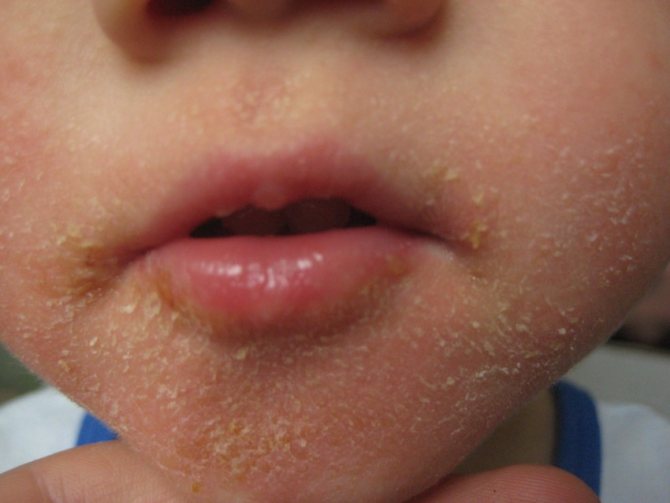
Approaches to diagnosis and treatment
If you suspect an allergy, take your baby to an allergist. The doctor will examine the little patient and collect anamnesis. He will assess the general state of health, find out whether there is a heredity (if the baby has one of the blood relatives with allergies, he is also at risk), and conduct a diagnosis.
Methods for identifying an allergen
- Parents analyze what new foods their baby has eaten recently or what else could trigger the reaction (for example, pets or apartment renovations).
- Allergy tests. Carried out if the provocateur could not be identified in a simple way. Performed only in a doctor's office.
- Provocative test. Performed if none of the tests helped identify the allergen. The procedure is carried out under the strict supervision of a doctor.
On an individual basis, the doctor can also refer you for other examinations - a coprogram, an analysis for lactase deficiency, etc.
General treatment regimen
Treatment depends on the triggering factor. Here's the general diagram:
- Eliminating the allergen. Excluding trigger foods from the diet (or from the mother’s diet if the baby is breastfed), eliminating the sting of an insect (after its bite), stopping contact with a pet (in case of a reaction to fur), etc.
- Nutrition correction. In the case of food allergies, the baby is prescribed a hypoallergenic diet (if complementary foods have already been introduced). For bottle-fed babies, the formula is changed.
- Prescribing antihistamines. They are prescribed only by a doctor. Medicines are produced in the form of tablets, drops, syrups - the doctor will select the medicine that is right for your baby. He will also prescribe the dosage and course of treatment.
- Local therapy. For skin reactions, ointments, creams, lotions, and emulsions are prescribed. They can be aimed at moisturizing and restoring the skin (emollients) or eliminating allergic symptoms (hormonal agents).
Remember that the treatment regimen is prescribed only by the doctor after examination and examination of the small patient.
Prevention of future relapses
If the provocateur is a food product, it is excluded. It is advisable to temporarily exclude any allergenic foods - gluten cereals, milk and dairy products, fish, citrus fruits, tomatoes and others.
If your baby has a reaction to insect bites, dress him in clothes with long sleeves and pants. Cover the stroller with a light cloth.
If your skin is hypersensitive to synthetics and other artificial fabrics, choose clothes for your child made from natural materials - ideally cotton.
If the reaction is to dust, do daily wet cleaning. Reduce the number of stuffed toys - these are known dust collectors. Monitor air humidity. Optimal - 40 - 60%. Buy a humidifier and hygrometer.
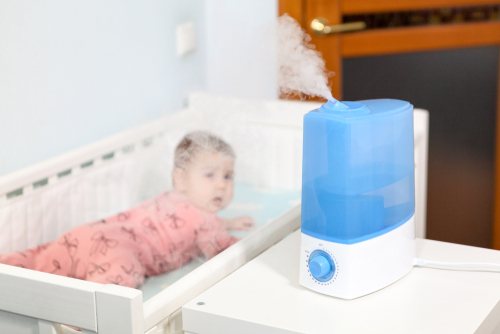
If you react to animal fur, limit your baby’s contact with your pet, keep the house clean—fur should not fly in the air or settle on the floor or furniture.
If you have a reaction to pollen, walk in cloudy, windless weather, ideally after rain. The sun, wind and dry air are your child’s enemies.



